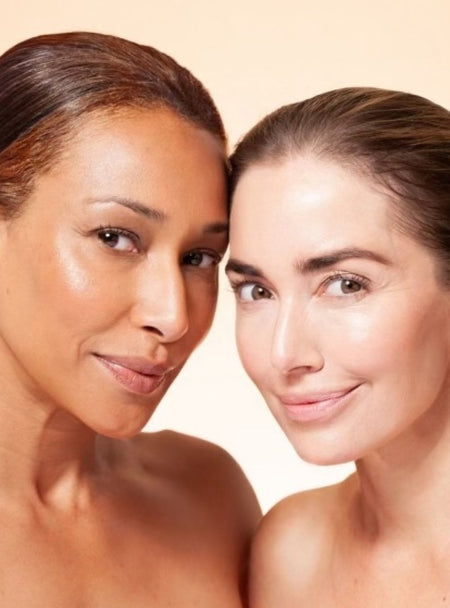Incorporating ice into your skincare routine can significantly enhance your skin's appearance. For optimal results, ice your face before applying skincare products. This practice can help close pores and tighten your skin, creating a smoother canvas for your products.
Using ice can also be an effective way to reduce puffiness and inflammation, especially after a long night. You'll find that your skin feels rejuvenated and ready to absorb the nutrients from your skincare line better.
As you explore how to integrate icing into your regimen, remember that this simple step can elevate your overall skincare experience. Experience the refreshing benefits that come from a chilled treatment and discover how it can complement your approach to skincare.
Understanding Skin Icing
Skin icing, a practice gaining popularity in skincare routines, utilizes cold therapy to enhance skin appearance and health. By applying ice or cold materials, you can experience various benefits such as reduced puffiness, improved circulation, and a brighter complexion.
The Science Behind Cold Therapy
Cold therapy, also known as cryotherapy, involves exposure to low temperatures to achieve therapeutic effects. When you ice your face, blood vessels constrict, reducing inflammation and puffiness. This mechanism helps with conditions like acne and rosacea.
Additionally, cold temperatures can stimulate collagen production, which is essential for maintaining skin elasticity and firmness. By incorporating skin icing into your regimen, you can enhance the absorption of your skincare products, ensuring they penetrate deeper into the skin. This process aids in overall skin rejuvenation, leading to a more youthful appearance.
Skin Icing Versus Traditional Ice Facials
Skin icing involves targeted application of ice to specific areas, while traditional ice facials usually consist of full-face coverage with ice-cold materials. Both methods aim to provide similar benefits, such as reducing redness and enhancing radiance.
With skin icing, you have more control over the areas you wish to treat, allowing for customized skincare. It’s effective for managing specific concerns like under-eye bags or forehead wrinkles. Ice facials, however, often provide a more intense cooling experience and can be invigorating.
In both approaches, the benefits include improved blood circulation and a refreshing sensation that can awaken tired skin. Experimenting with your preferred method can help you determine what best suits your skincare needs.
Preparing for Skin Icing
Before you start icing your face, it's essential to prepare both your skin and your tools effectively. The right ingredients and pre-icing skincare steps can significantly enhance the benefits of skin icing for your routine.
Selecting the Right Ingredients
Using the right ingredients can boost the efficacy of your skin icing. Consider ice cubes made from green tea for added antioxidants. Green tea can help fight free radicals and reduce inflammation.
Alternatively, you might want to use aloe vera ice cubes. Aloe soothes the skin and provides hydration, making it an excellent choice for those with sensitive skin.
If you prefer a refreshing spray before icing, rose water works well. It hydrates and calms the skin, preparing your complexion for the cooling effect. You can also mix glycerin with water to create an effective skin barrier, ensuring moisture retention during the icing process.
Pre-Icing Skin Care Steps
Before applying ice to your face, follow specific skin care steps. Start by cleansing your face thoroughly to remove any dirt or impurities. This ensures that the ice can penetrate effectively without obstruction.
Next, consider applying a vitamin C serum. Vitamin C promotes brightness and can enhance the effects of cooling. Allow the serum to absorb for a few minutes before you begin icing.
Once your skin is primed, use a gentle exfoliant if needed. This step removes dead skin cells, allowing the benefits of icing to show more prominently. Finish with a light moisturizer to lock in hydration before icing, which will help your skin stay smooth and plump.
Executing the Ice Therapy
To effectively incorporate ice therapy into your skincare routine, you should understand proper application techniques and how to protect sensitive skin. Both aspects are essential for maximizing benefits while minimizing risks, especially if you experience conditions like rosacea or have sensitive skin.
Techniques for Effective Ice Application
When applying ice to your face, several methods can enhance effectiveness. Consider using ice rollers or ice globes designed specifically for facial use. These tools allow for smoother and more controlled application, which can help reduce puffiness and inflammation.
If you prefer a more straightforward approach, a frozen spoon can also work well. Place it in the freezer for a few minutes before using it on the under-eye area to tackle dark circles and swelling. It's best to use ice immediately after cleansing your skin to prep it for other skincare products.
Always apply ice in gentle, circular motions, focusing on areas that need extra attention like your cheeks and under the eyes. Limit each session to about 5-10 minutes to prevent any discomfort or adverse reactions.
Protecting Sensitive Skin
If you have sensitive skin, you must take extra precautions when icing your face. Start by wrapping ice cubes in a clean cloth or using a dedicated ice roller to create a barrier. This minimizes the risk of irritation, especially for conditions like rosacea, which can react negatively to direct cold.
Before icing, ensure your skin is clean and dry. Avoid using ice on broken or irritated areas, as this can exacerbate the problem. If any discomfort arises during application, stop immediately.
Experimenting with the duration and technique can help you find what suits your skin best. Always monitor your skin's response to avoid potential irritation and ensure a positive experience with ice therapy.
Integrating Ice Icing into Skincare Routine
Incorporating ice icing into your skincare routine can enhance the benefits of your products and improve your overall skin health. Understanding when and how to use ice will help optimize your skincare regime for better results.
Determining the Ideal Sequence
To maximize the benefits of icing, apply ice before your skincare products. Start with a clean face to ensure that your skin can absorb the subsequent products effectively.
Use ice for about 5-10 minutes to cool and depuff your skin. This method helps tighten pores and improves blood circulation. Aim for specific areas like under the eyes or on any inflamed spots.
After icing, your skin is primed for moisturizer and serums. Opt for lightweight formulas that penetrate well, such as those containing primrose oil, to support your skin barrier. This sequence will give your skin an immediate refreshing effect.
Post-Icing Skincare Products
Following icing, selecting the right skincare products is crucial for maintaining hydration and nourishment. Use a hydrating serum right after icing to lock in moisture. This helps your skin retain water, further enhancing its appearance.
After the serum, apply a quality moisturizer. Look for products with ingredients like hyaluronic acid that deliver deep hydration.
Consider incorporating antioxidants as well, which help protect your skin from environmental damage. This combination will safeguard your skin barrier while providing essential nutrients.
Together, these steps not only improve your skin's texture but also prepare it for the day ahead, ensuring you maintain a healthy, glowing complexion.
Benefits and Side Effects
Icing your face can offer several physical and cosmetic advantages, as well as some cautions to consider. Understanding both the benefits and potential side effects will help you make an informed decision about incorporating this method into your skincare routine.
Physical and Cosmetic Advantages
Using ice on your face can effectively tighten pores, creating a smoother appearance. The cold temperature helps constrict blood vessels, which can reduce puffiness, especially around the eyes. This can lead to a more refreshed look.
In addition to these immediate effects, regular use of ice may promote collagen production. Increased collagen can aid in minimizing fine lines and achieving a natural glow. Furthermore, improved blood circulation from the cold can enhance your skin's overall health.
Some people find that applying ice helps with cystic acne, as it can reduce inflammation and soothe irritated skin. The cooling effect can also serve as a beneficial preparation step before applying other skincare products, making your routine more effective.
Cautions for Ice Therapy
While there are benefits, there are also important cautions to keep in mind. Prolonged exposure to ice can lead to skin irritation or frostbite. It is crucial to avoid applying ice directly for extended periods; wrapping ice in a cloth can help prevent damage.
For those with sensitive skin or conditions like rosacea, ice therapy might worsen irritation or redness. You should monitor how your skin reacts during the initial applications.
If you are pregnant or have certain skin conditions, consulting with a professional before starting this practice is advisable. This will ensure that you understand how ice therapy may affect your unique skin type and overall health.
Frequently Asked Questions
Facial icing can enhance your skincare routine, but understanding its timing and application is essential. Here are specific answers to common questions about incorporating ice into your skincare regimen.
Is it better to apply ice to the face before or after moisturizing?
It is generally recommended to apply ice before moisturizing. Cooling the skin can reduce puffiness and enhance the absorption of moisturizers and other skincare products that follow.
What are the potential disadvantages of applying ice directly to the skin?
Applying ice directly can sometimes cause irritation or a cold burn if done for too long. It's essential to use a barrier, such as a cloth, to protect your skin and limit exposure time.
Can icing the face be included as part of a daily skincare routine?
Yes, you can incorporate facial icing into your daily skincare routine. Many people find it beneficial to do so in the morning to refresh the skin and reduce puffiness before applying makeup or other products.
How long is it recommended to ice the face for optimal benefits?
Icing the face for about 1 to 3 minutes is usually sufficient. Prolonged exposure can lead to adverse effects, so it's best to keep it brief.
Should ice globes be used before or after applying skincare products?
Ice globes are best used before applying skincare products. They help prepare the skin by cooling and de-puffing, making it easier for subsequent products to penetrate.
What is the most effective time of day to incorporate facial icing into skincare?
The morning is often considered the most effective time to ice your face. It can energize your skin and help in reducing overnight puffiness, setting a fresh tone for the day.

